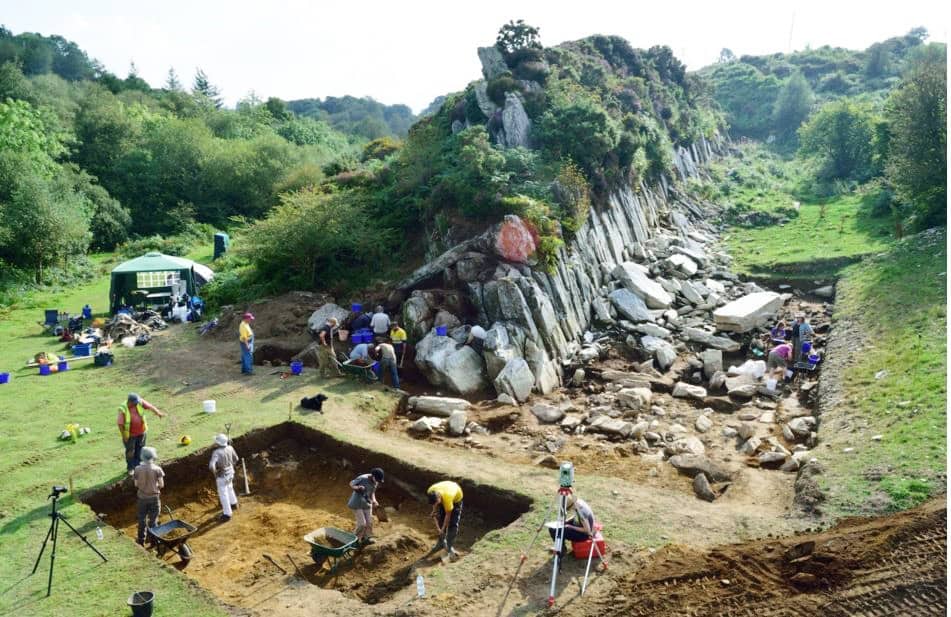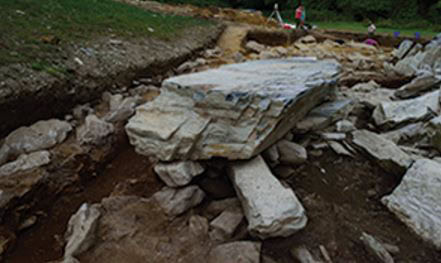The Stonehenge bluestones came from two quarries in Wales, where they were mined and then transported 140 miles (225 km) to where the prehistoric monument is located today – near the city of Salisbury in Wiltshire, England. The large megaliths were either used for local monuments first or moved immediately, scientists say.
A team of archaeologists and geologists from University College London (UCL), Bournemouth University, the University of Southampton, Amgueddfa Cymru (National Museum Wales), the University of Leicester, the Dyfed Archaeological Trust, and the University of Manchester, wrote about their study and conclusions in the academic journal Antiquity.
The research team presented evidence after carrying out excavations at two quarries in Wales. They confirmed that the Stonehenge’s bluestones came from the two quarries, a finding that sheds light on how they were extracted and transported thousands of years ago.
 Excavations at Craig Rhos-y-felin, 140 miles from Stonehenge. (Image: ucl.ac.uk. Credit: Adam Stanford © Aerial-Cam Ltd)
Excavations at Craig Rhos-y-felin, 140 miles from Stonehenge. (Image: ucl.ac.uk. Credit: Adam Stanford © Aerial-Cam Ltd)
May help answer why Stonehenge was built
The authors presented detailed evidence of prehistoric quarrying in the Preseli hills in Pembrokeshire, southwest Wales. They say their findings help answer several long-standing questions regarding when, how and why Stonehenge was built.
The huge, vertically-standing stones at Stonehenge are of a local sandstone called ‘sarsen’. The smaller ones, known as bluestones, came from the Preseli hills in the Pembrokeshire Coast National Park.
Since the 1920s, geologists have known these the bluestones came to Stonehenge from somewhere in the Preseli Hills region. It was not until this new study that archaeologists got together to locate and excavate the actual quarries from which they came.
Project leader, Professor Mike Parker Pearson, who works at UCL’s Institute of Archaeology, said:
“This has been a wonderful opportunity for geologists and archaeologists to work together. The geologists have been able to lead us to the actual outcrops where Stonehenge’s stones were extracted.”
Stonehenge’s bluestones are of igneous and volcanic rocks, the most common of which are called rhyolite and dolerite.
Two outcrops identified as sources of the bluestones
Dr. Richard Bevins, of the National Museum of Wales and Dr. Rob Ixer, from the University of Leicester and UCL, identified the outcrop of Carn Goedog as the principal source of the ‘spotted dolerite’ in Stonehenge, and the Craig Rhos-y-felin as the main source for one of the ‘rhyolite’ bluestones.
The article in Antiquity includes details of excavations at Craig Rhos-y-felin.
The rocks’ special formation, which forms natural pillars at these outcrops, allowed the quarry-workers all those thousands of years ago to detach each standing stone (megalith) without much effort.
 Megaliths like this one, found at a quarry in Wales, would have been detached by quarry-workers thousands of years ago with a minimum of effort. (Image: journals.cambridge.org)
Megaliths like this one, found at a quarry in Wales, would have been detached by quarry-workers thousands of years ago with a minimum of effort. (Image: journals.cambridge.org)
Dr. Josh Pollard, from the University of Southampton, said:
“They only had to insert wooden wedges into the cracks between the pillars and then let the Welsh rain do the rest by swelling the wood to ease each pillar off the rock face.”
“The quarry-workers then lowered the thin pillars onto platforms of earth and stone, a sort of ‘loading bay’ from where the huge stones could be dragged away along trackways leading out of each quarry.”
Two outcrops may have had special significance
Neolithic quarries expert, Professor Colin Richards, from the University of Manchester, said:
“The two outcrops are really impressive – they may well have had special significance for prehistoric people. When we saw them for the first time, we knew immediately that we had found the source.”
Radiocarbon-dating of charcoal and burnt hazelnuts from the camp fires of the quarry workers indicates that there were many occurrence of megalith-quarrying at these outcrops.
 “With a history spanning 4,500 years Stonehenge has many different meanings to people today. It is a wonder of the world, a spiritual place and a source of inspiration. The Stone Circle is a masterpiece of engineering,” writes English Heritage. (Image: english-heritage.org.uk)
“With a history spanning 4,500 years Stonehenge has many different meanings to people today. It is a wonder of the world, a spiritual place and a source of inspiration. The Stone Circle is a masterpiece of engineering,” writes English Heritage. (Image: english-heritage.org.uk)
Stonehenge, one of the most famous sites in the world, comprising the remains of a ring of standing stones set within earthworks, was built between 4,000 and 5,000 years ago, during the Neolithic.
Both of the Preseli quarries were exploited in the Neolithic, and Craig Rhos-y-felin was also quarried around 4,000 years ago during the Bronze Age.
Perhaps bluestones were first used in a local monument
Professor Parker Pearson, said:
“We have dates of around 3400 BC for Craig Rhos-y-felin and 3200 BC for Carn Goedog, which is intriguing because the bluestones didn’t get put up at Stonehenge until around 2900 BC.”
“It could have taken those Neolithic stone-draggers nearly 500 years to get them to Stonehenge, but that’s pretty improbable in my view. It’s more likely that the stones were first used in a local monument, somewhere near the quarries, that was then dismantled and dragged off to Wiltshire.”
Professor Kate Welham, from Bournemouth University, believes the ruins of any monument that had been dismantled lie somewhere between the two megalith quarries.
Prof. Welham said:
“We’ve been conducting geophysical surveys, trial excavations and aerial photographic analysis throughout the area and we think we have the most likely spot. The results are very promising – we may find something big in 2016.”
These two megalith quarries are on the north side of the Preseli hills, a location that undermines previous theories regarding how the bluestones were moved from Wales to Stonehenge.
It had been suggested by previous writers that the bluestones were transported southwards from the hills to Milford Haven, and then floated on rafts or boats. This now seems highly unlikely.
Prof. Parker Pearson said regarding how the bluestones were transported:
“The only logical direction for the bluestones to go was to the north then either by sea around St David’s Head or eastwards overland through the valleys along the route that is now the A40. Personally I think that the overland route is more likely.”
“Each of the 80 monoliths weighed less than 2 tons, so teams of people or oxen could have managed this. We know from examples in India and elsewhere in Asia that single stones this size can even be carried on wooden lattices by groups of 60 – they didn’t even have to drag them if they didn’t want to.”
Phil Bennett, Culture & Heritage Manager at the Pembrokeshire Coast National Park Authority, said:
“This project is making a wonderful contribution to our knowledge of the National Park’s importance in prehistory.”
The findings from this latest study could also help us understand why Stonehenge was built. The authors believe the bluestones were erected about 2900 BC at Stonehenge, several hundred years before the giant sarsens were put up, around 2500 BC.
Prof. Parker Pearson said:
“Stonehenge was a Welsh monument from its very beginning. If we can find the original monument in Wales from which it was built, we will finally be able to solve the mystery of why Stonehenge was built and why some of its stones were brought so far.”
The scientists say further excavations are planned for next year.
Citation: “Craig Rhos-y-felin: a Welsh bluestone megalith quarry for Stonehenge,” Mike Parker Pearson, Richard Bevins, Rob Ixer, Joshua Pollard, Colin Richards, Kate Welhan, Ben Chan, Kevan Edinborough, Derek Hamilton, Richard Macphail, Duncan Schlee, Jean-Luc Schwinniger, Ellen Simmons and Martin Smith. Antiquity, Volume 89, Issue 348. 7th December, 2015. DOI: http://dx.doi.org/10.15184/aqy.2015.177.
Video – Who built Stonehenge?
This English Heritage video was produced before the study mentioned above. It provides a behind the scenes look at the fascinating work being done by English Heritage volunteers to recreate the homes of the people who built Stonehenge.

